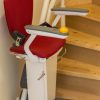
The Rising Demand for Stairlifts in Ireland
Across Ireland, stairlifts are steadily becoming an essential fixture in many homes—not just a practical necessity, but a symbol of independence, modern living, and thoughtful design. Let’s explore how this trend has grown, why it's gaining traction, and what it means for homeowners, families, and industry alike.
1. A Demographic Shift: Ageing Gracefully at Home
Ireland’s population is ageing. While once largely focused on younger generations, more and more households now include older adults keen to remain living independently. Rather than moving to nursing homes or purpose built communities, many are adapting existing homes to suit their changing mobility needs.
Staircases—once taken for granted—have become a daily obstacle for those with limited mobility, frailty, or recovery from illness. A stairlift offers a safe, dignified way to stay home safely, rising in popularity as awareness spreads through families and health professionals.
2. Safety Considerations: Reducing Risks, Enhancing Peace of Mind
Falls on stairs remain one of the leading causes of serious injury among older adults. By installing a stairlift, homeowners can significantly reduce this risk. For many families, the peace of mind gained is worth every euro—especially when compared to medical bills, home adaptations after injury, or relocation costs.
Moreover, with modern safety features—such as seat belts, obstruction sensors, swivel seats, and smoothly controlled speeds—stairlifts come with multiple layers of protection, reflecting advances in design and engineering.
3. Modern Design Meets Function
Gone are the days of clunky, obtrusive stairlifts. Contemporary models blend sleek, compact design with clever engineering. Rail systems are now narrow and often fitted to the staircase’s side, leaving walking space free. Folds, discreet controls, and soft finishes ensure they integrate into the home without dominating it.
This design evolution has made them more acceptable for families who worry about aesthetic impact. With a range of finishes—white, chrome, muted pastels—homeowners can match stairlifts to interior décor, reinforcing the idea that accessibility need not mean sacrificing style.
4. Economic Accessibility & Government Support
A key driver behind growing adoption in Ireland is financial accessibility. While stairlifts remain an investment, the costs have come down thanks to technological improvements, increased competition, and evolving financing options.
Some insurers and government schemes in Ireland now assist older residents with grants or rebates to help retrofit homes for accessibility needs. While eligibility varies, households can offset a portion of installation costs, encouraging earlier adoption—often before mobility becomes severely restricted.
Moreover, stairlift providers like O Connor Carrol Stairlifts in Dublin and homecaremedicalequipment.ie/stairlifts-in-dublin/ often offer flexible payment plans: leasing, hire purchase, or rent to own options. These allow families to spread the cost or adapt to temporary needs—like recovery from surgery—without full upfront expenditure.
5. Local Availability & Improved Service Networks
Another factor fueling the rise is improved local service networks across Ireland. Key cities such as Dublin, Cork, Limerick, and Galway, along with rural regional centres, now have dedicated stairlift suppliers offering end-to-end services—free home assessments, tailored installations, maintenance contracts, and quick response servicing.
This broader coverage dispels the previous perception that stairlifts were only for particular urban enclaves or specialised markets. Knowing a local provider is nearby boosts trust and convenience.
6. A Ripple Effect: Word of Mouth & Health Care Endorsements
Perhaps most powerful of all is word of mouth. Families who’ve installed stairlifts often share their experiences with neighbours, relatives, and community groups. This grassroots promotion—from parish halls to friendly WhatsApp groups—is creating a virtuous cycle of awareness and uptake.
Similarly, GPs, occupational therapists, and physios have become important advocates. When medical professionals recommend stairlifts as a preventative measure—rather than waiting for a fall—it conveys urgency and normalises their use. Anecdotes from practitioners emphasise how early installation can extend independence by years, reduce anxiety, and even slow functional decline.
7. Innovation & Patient Centred Features
Not one to stand still, the stairlift industry is now offering features that appeal specifically to the Irish market:
• Outdoor models suited for homes with external access.
• Swivel seats that aid safe transfers at the top or bottom of stairs.
• Power fold rails that retract at bends or landings, minimising protrusion.
• Backup batteries, ensuring operation during power outages—a critical feature in rural areas.
• Smart tracking and remote diagnostics, enabling rapid response to faults or maintenance needs.
These innovations all contribute to improved user experience, adding reassurance for both users and their families.
8. Adapting Homes for the Long Term
An important trend is adopting stairlifts earlier in the life cycle of mobility challenges rather than as emergency responses. Families, often with aging parents in mind, proactively fit stairlifts to accommodate early signs of mobility impairment—such as arthritis, post operative recovery, or gradual balance issues.
This approach helps keep homes functional and accessible as needs evolve—eliminating the urgency or stress of quick retrofits. It also distributes the cost of adaptation across time, which feels more manageable than sudden outlay under pressure.
9. Environmental and Sustainability Considerations
With increased awareness of sustainability across Irish households, many stairlift manufacturers and installers now emphasise reduced environmental impact. Energy efficient motors, recyclable materials, and long lasting systems mean that modern stairlifts are more eco friendly than older models.
Installers often offer refurbishment services—extending the service life of units, reducing waste, and lowering carbon footprints. This aligns with broader national goals of sustainability and responsible consumption.
Looking Forward: A Futureproof Choice
As Ireland faces demographic shifts, rising longevity, and a strong desire to “age in place”, stairlifts are becoming far more than niche mobility aids—they’re strategic tools for inclusive, safe, and dignified homes.
Expect to see:
• More modular systems that can be adapted to new staircases if homeowners move.
• Smart home integration, like voice control or mobile app operation for those with dexterity challenges.
• Community based outreach, with councils or charities providing demonstration days in local halls.
• Greater local manufacturing or assembly, boosting rural employment while reducing lead times and transport emissions.
A Gentle Revolution in Homes Across Ireland
What once was viewed as purely functional is now widely seen as a proactive, stylish, and empowering choice. By transforming homes one staircase at a time, stairlifts are quietly reshaping how Ireland grows older—ensuring that independence, security, and peace of mind remain within reach.
Whether you're considering a stairlift for yourself, a loved one, or simply observing this trend, it’s clear: stairlifts are more than mobility aids—they’re enablers of home, comfort, and dignity.

















